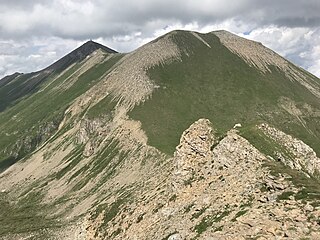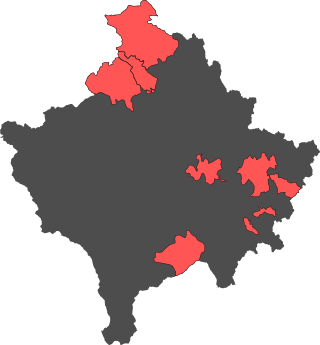
The Gorani or Goranci, are a Slavic ethnic group inhabiting the Gora region—the triangle between Kosovo, Albania, and North Macedonia. They number an estimated 60,000 people, and speak a transitional South Slavic dialect, called Goranski. The vast majority of the Gorani people adhere to Sunni Islam.

Mitrovica, also referred to as South Mitrovica, is a city in northern Kosovo and administrative center of the District of Mitrovica. In 2013, the city was split into two municipalities, South Mitrovica and North Mitrovica. Settled 10 km (6.2 mi) from Ujmani/Gazivoda Lake, on the confluence of the rivers Ibër, Sitnicë, Lushta, and Trepça, the city is surrounded by the mountains of Kopaonik, Rogozna, Mokna, and Çyçavica. According to the 2011 Census, the two municipalities had 97,686 inhabitants of which 85,360 reside in south and 12,326 in north.

Prizren is the second most populous city and municipality of Kosovo and seat of the eponymous municipality and district. It is located on the banks of the Prizren River between the foothills of the Sharr Mountains in southern Kosovo. Prizren experiences an oceanic climate under the influence of the surrounding mountains.

The Šar Mountains or Sharr Mountains is a mountain range in Southeast Europe, extending into several countries from southern Kosovo, to northwestern North Macedonia, to northeastern Albania. The sections in Kosovo, and in North Macedonia are national parks. Rugged and barren, the mountains are among the highest in the Balkans, with 30 peaks higher than 2,500 m (8,202 ft).

The Prizren District is one of the seven districts of Kosovo. Its seat is in the city of Prizren. According to the 2011 Census, it has a population of 331,670 and an area of 2,024 square km. Albanians form the majority of the district (85%). However, the district of Prizren is home to the biggest Bosniak and Turkish population in Kosovo, who make around 10% of the district's total population.

A municipality is the basic administrative division in Kosovo and constitutes the only level of power in local governance. There are 38 municipalities in Kosovo; 27 of which have an Albanian ethnic majority, 10 Serb and 1 Turkish. After the 2013 Brussels Agreement, signed by the governments of Kosovo and Serbia, an agreement was made to create a Community of Serb Municipalities, which would operate within Kosovo's legal framework. Since 2013, the agreement has not been fulfilled by Kosovo's authorities, calling upon its constitution and territorial integrity.

The Civic Initiative of Gora is a Gorani political party in Kosovo.

Gora is a geographical region in southern Kosovo and northeastern Albania, primarily inhabited by the Gorani people. Due to geopolitical circumstances, some of the local Gorani people have over time also self declared themselves as Albanians, Macedonians, Bosniaks, Bulgarians, Serbs, Turks and Muslims by ethnicity.

The municipalities and cities are the first-level administrative division and the basic level of local government of Serbia. The country is divided into 145 municipalities and 29 cities.

The Gorani or Goranski, also Našinski language, is a regiolectal variety of South Slavic spoken by the Gorani people in the border area between Kosovo, North Macedonia, and Albania. It is part of the Torlakian dialect group, which is transitional between Eastern and Western South Slavic languages.

Opolje is a region in the southern part of the municipality of Prizren in southern Kosovo. The region has 19 villages mainly inhabited by Kosovo Albanians.

Brod is a village in the municipality of Dragash in southern Kosovo. It is part of the District of Prizren and of the region called Gora. The majority of people are Gorani. Brod is a big village with 900 houses.

A District is the highest level of administrative divisions of Kosovo. The districts of Kosovo are based on the 2000 Reform of the UNMIK-Administration.

Srecka or Sredačka Župa is a remote geographical region, a valley, in southeastern Kosovo, below the Šar Mountains at the source of the Prizren Bistrica.

Ferizaj or Uroševac, is a city and a municipality in Kosovo. It is the third largest city in Kosovo by population and also the seat of Ferizaj Municipality and the Ferizaj District.

Bosniaks in Kosovo are a South Slavic Muslim ethnic group living in Kosovo, numbering 27,553 according to the 2011 census. The vast majority of Bosniaks are adherents of Sunni Islam.

Community of Serb Municipalities is a planned inter-municipal association of ethnic Serb majority municipalities in Kosovo.

The Kosovo Agency of Statistics monitors various demographic features of the population of Kosovo, such as population density, ethnicity, education level, health of the populace, economic status, religious affiliations and other aspects of the population. Censuses, normally conducted at ten-year intervals, record the demographic characteristics of the population. According to the first census conducted after the 2008 declaration of independence in 2011, the permanent population of Kosovo had reached 1,810,366. The latest census started on 5th of April 2024 and according to the preliminary results, the Republic of Kosovo has 1,586,659 inhabitants, of which 795,046 are men (50.1%) and 791,614 are women (49.9%).
The Battle of Lumë, also referred by the Albanians as the Uprising of Lumë, was a series of clashes between the Albanian locals of the region of Lumë in Ottoman Albania against the invading Serbian army in 1912 during the First Balkan War period. As the Kingdom of Serbia sought to gain access to the Adriatic Sea, the Serbian army met significant resistance from Albanian militia in the Luma region, resulting in the defeat of the Serbian forces. In securing the central Adriatic coast in Albania, Albanian political figureheads were able to disembark in Durrës and proceed with their plans for the eventual Albanian Declaration of Independence.

The United Gorani Party is a Gorani political party in Kosovo.


























